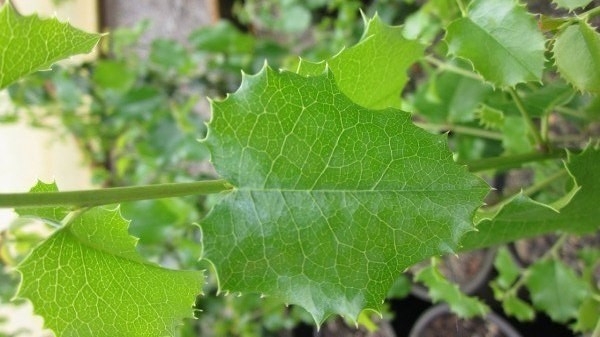Hollyleaf cherry
(Prunus ilicifolia ilicifolia)

Description
Prunus ilicifolia (Common names: hollyleaf cherry, evergreen cherry; islay - Salinan Native American) is native to the chaparral areas of coastal California (from Mendocino County to San Diego County), Baja California, and Baja California Sur. as well as the desert chaparral areas of the Mojave desert. Despite its name, it is not a true cherry (P. subg. Cerasus) species. It is traditionally included in P. subg. Laurocerasus, but molecular research indicates it is nested with species of P. subg. Padus. Prunus ilicifolia is an evergreen shrub to tree, producing edible cherries, with shiny and spiny toothed leaves similar in appearance to those of holly. This resemblance is the source of both the common name "holly-leaved cherry" and the scientific epithet "ilicifolia" (Ilex-leaved). It grows 8 to 30 feet (240 to 910 centimetres) tall, with thick, alternate leaves 1 to 2 inches (2.5 to 5.1 centimetres) in length. It has small white flowers growing in clusters, similar in appearance to most members of the rose family, Rosaceae, flowering from March to May. The flowers are terminal on small stalks, with the youngest at the cluster center. The purple to black fruit is sweet, with a very thin pulp around a large single stone (drupe). The plant is prized for cultivation, showy and easily grown from seed, and has been cultivated for centuries as a food source, and tolerates twice yearly pruning when often used as a hedge. The plant likes full sun, loose open soil (porous), and tolerates drought conditions well, but needs regular watering when young. Bees are attracted to it. "Prunus" comes from the old Latin for "plum". "Ilici - folia means "holly like - leaves". This is the only species of the genus Prunus native to the Santa Monica Mountains that divide the Los Angeles basin from the San Fernando Valley, California. It is an evergreen shrub or small tree approaching 15 meters (49 feet) in height, with dense, hard leaves (sclerophyllous foliage). The leaves are 1.6–12 cm (0.63–4.72 in) long with a 4–25 mm (0.16–0.98 in) petiole and spiny margins, somewhat resembling those of the holly. The leaves are dark green when mature and generally shiny on top, and have a smell resembling almonds when crushed; these are poisonous to eat, but not to handle. The flowers are small (1–5 mm), white, produced on racemes in the spring. The fruit is a cherry 12–25 mm diameter, edible and sweet, but contains little flesh surrounding the smooth seed.
Taxonomic tree:







